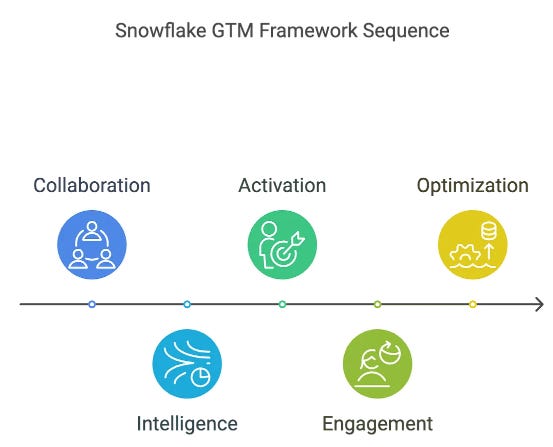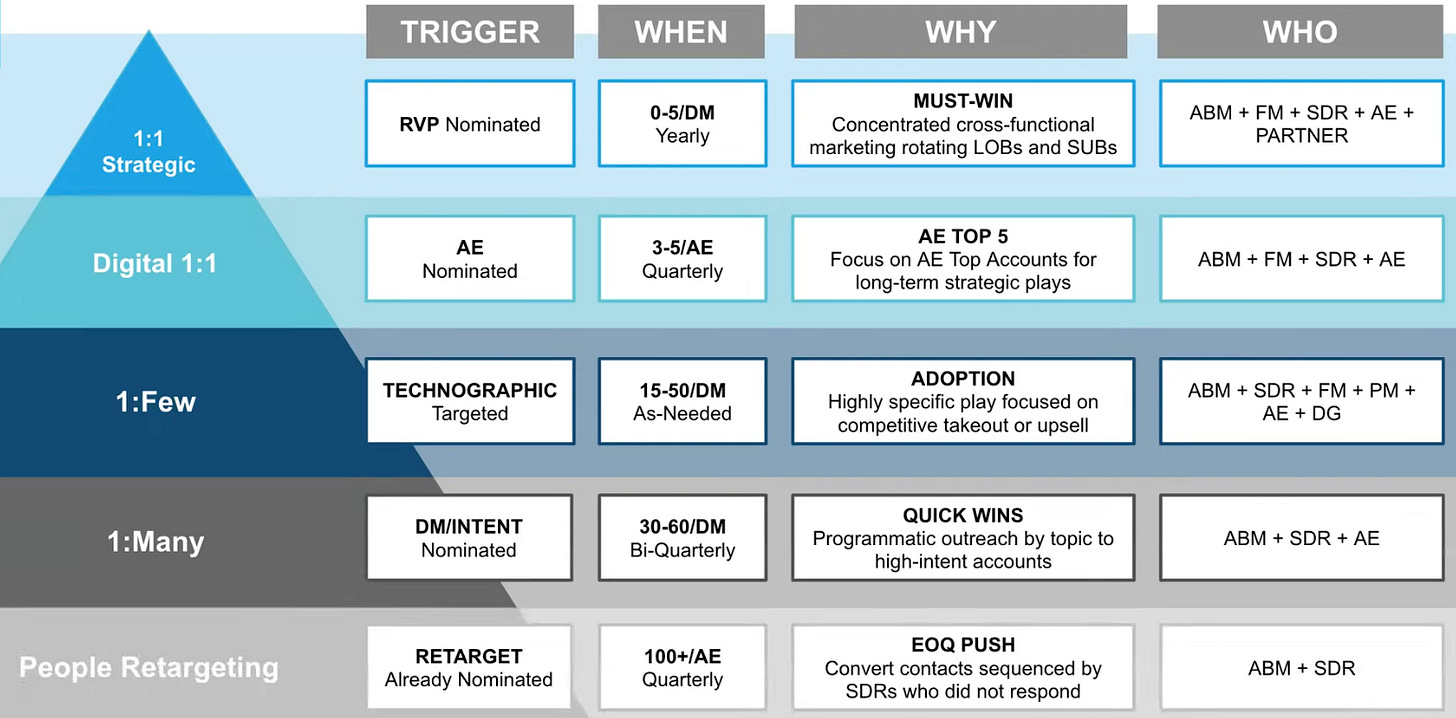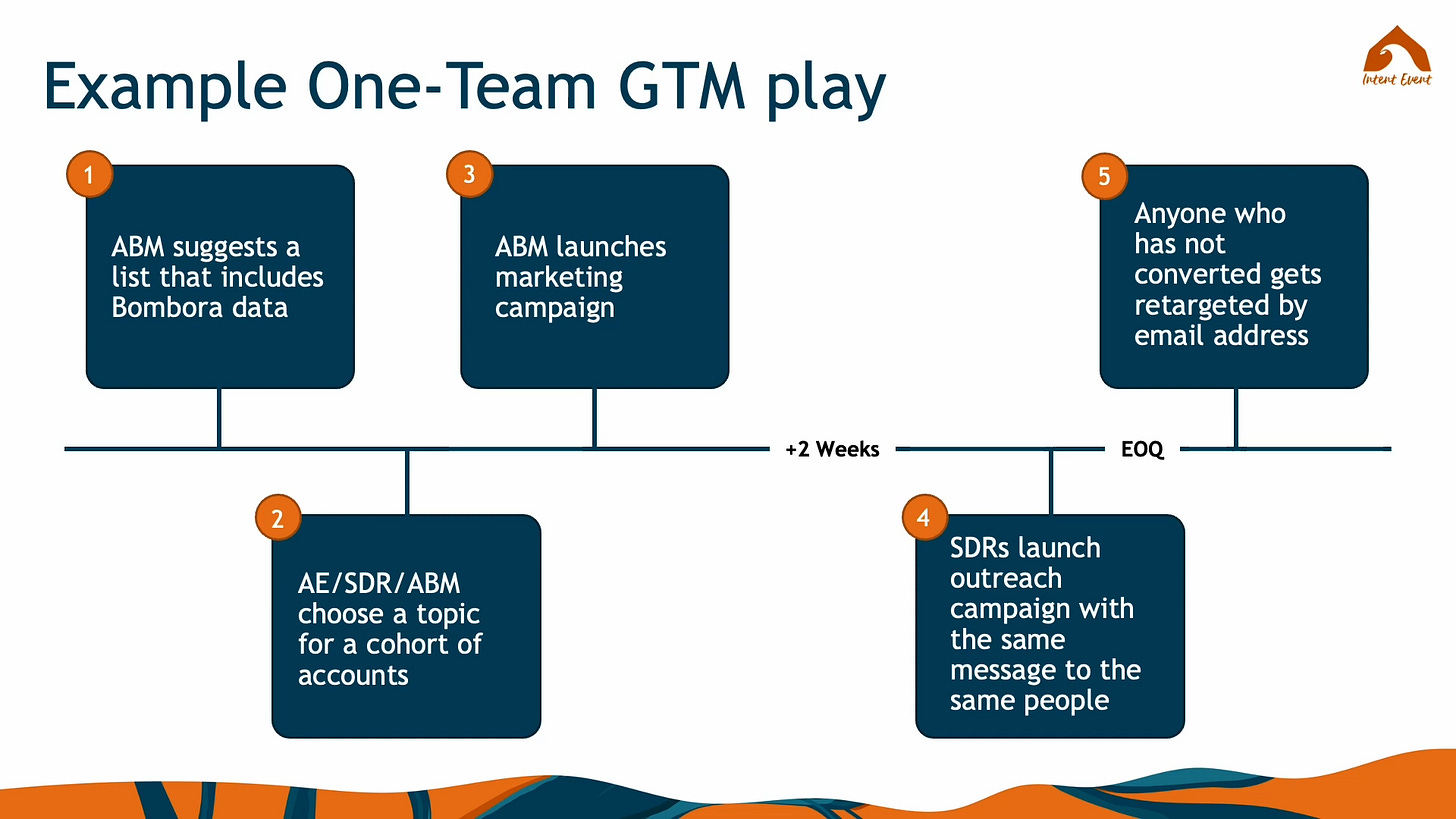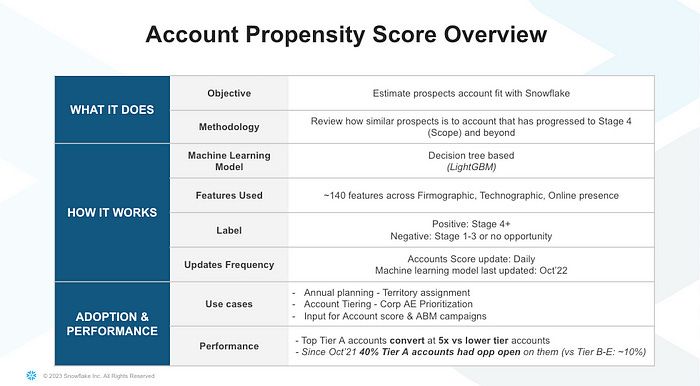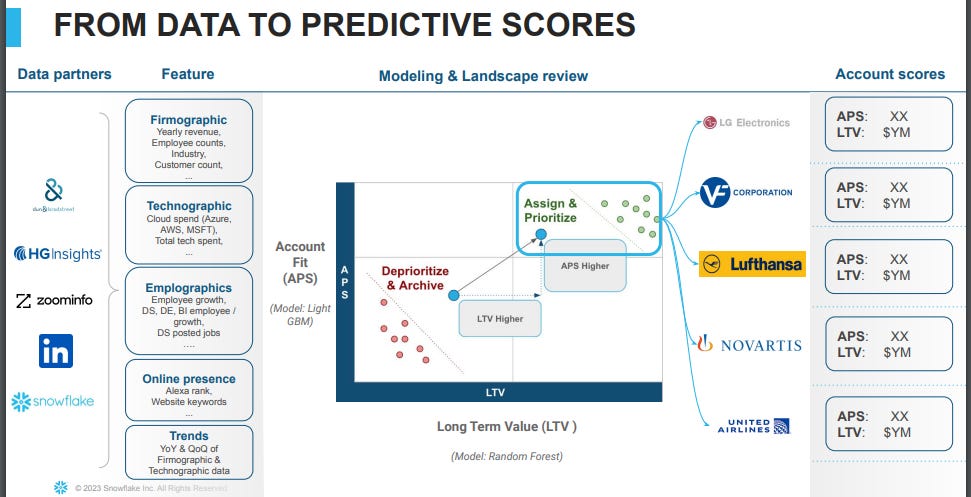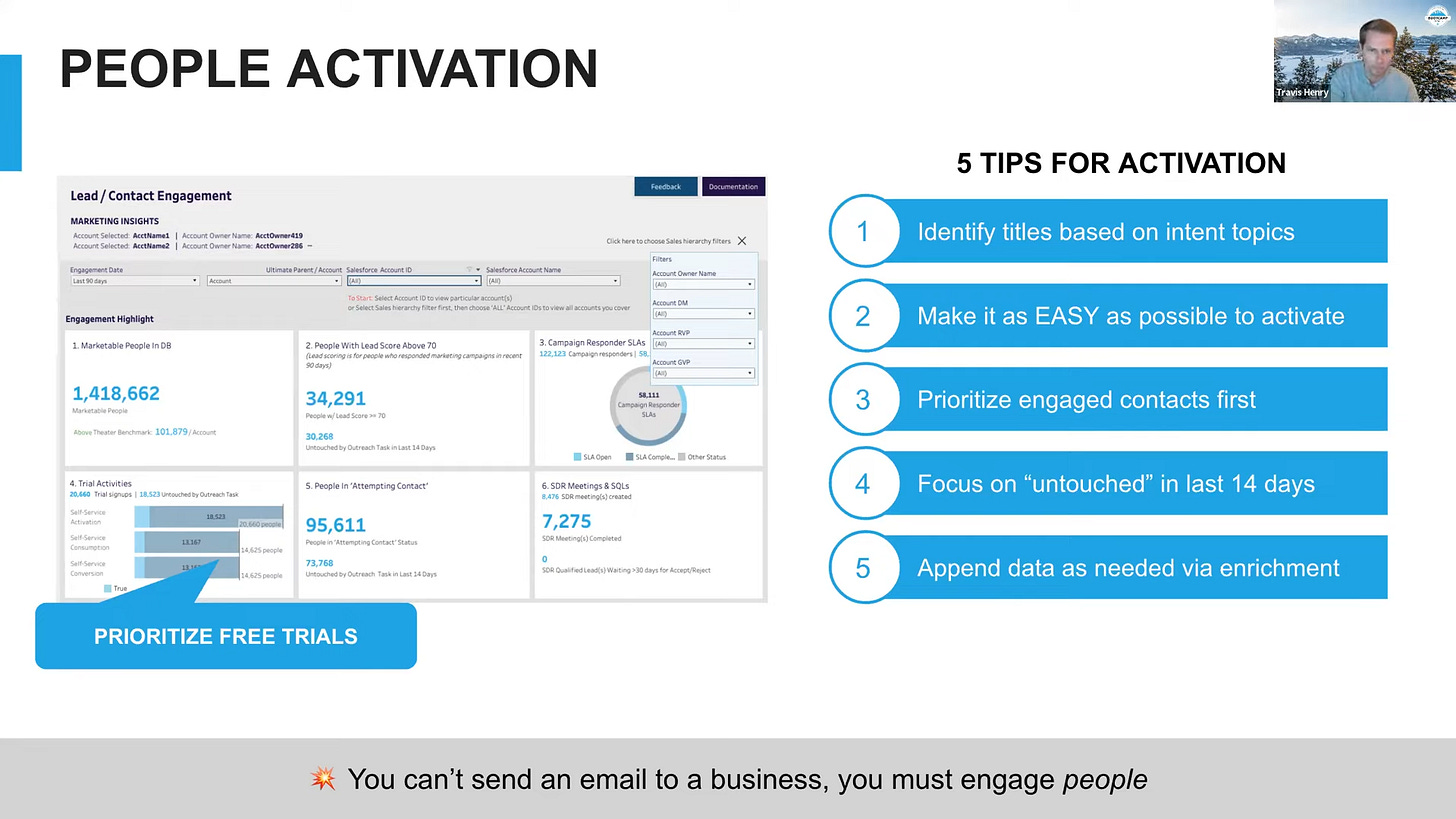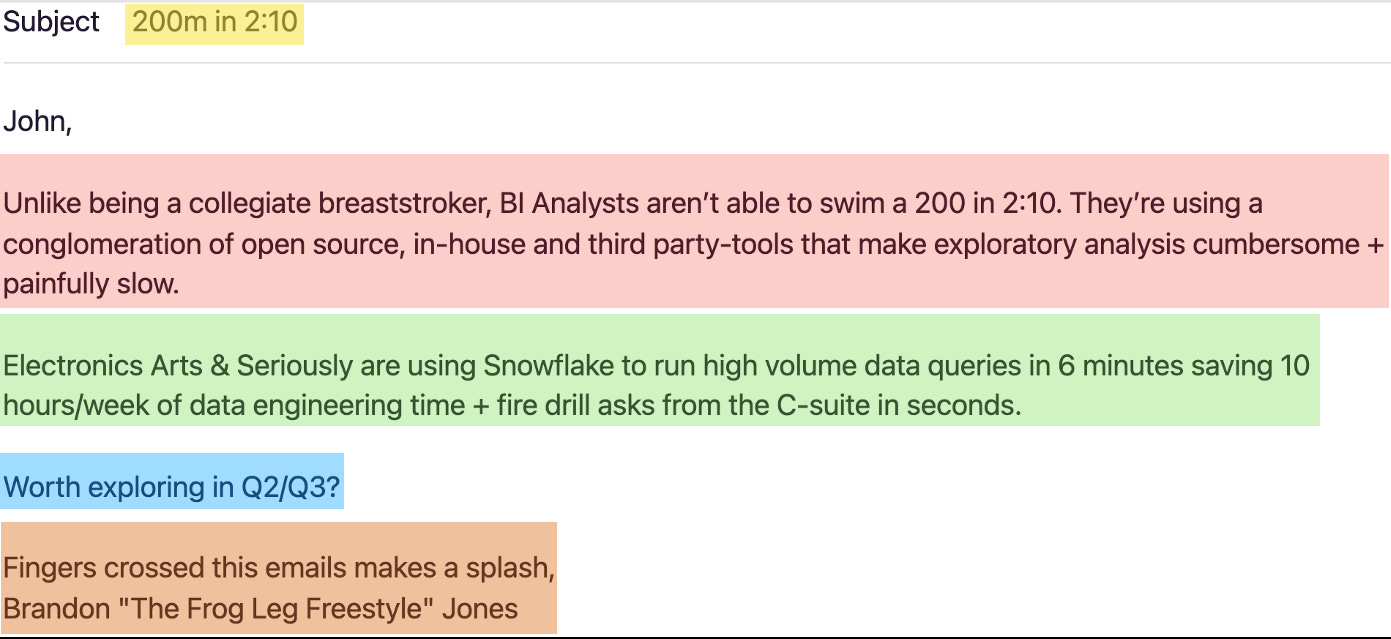How Snowflake Scaled Outbound to $4B ARR
Snowflake hit $4B ARR with 60% of pipeline from SDRs. Learn how they built their outbound engine and ABM strategy, plus 5 lessons you can apply today.
Read time: 25 min
👋 Hey, Elric here! Welcome to this week’s free edition of Outbound Kitchen. Every week, I break down real questions about scaling outbound so you can turn it into your #1 growth engine. Thinking about upgrading to the paid newsletter? Here’s what you’ll get:
Instant access to 16 paid newsletters, including:
My Outbound Chef Kit: 100+ resources (email templates, cold call scripts, AI prompts, top outbound tools, and more, everything the best outbound teams use. Worth $1,000+)
The subscription costs $178/year (or $22/month). And the best part? You can try it free for 7 days. Cancel anytime.
But I think you'll love it!
👉 Start your free trial today.
Last time, I broke down Rippling’s $350M ARR outbound engine.
Today, let’s dive into Snowflake’s $3B outbound strategy.
Before you roll your eyes and think, “Of course, they can do that, they’re huge!” Let me stop you.
Yes, Snowflake has 8,000+ employees, 2,000+ sales reps, and a budget you can only dream of.
But that doesn’t mean there’s nothing to learn.
Here’s the deal:
I’ll unpack what they do, and show you how to apply their strategies, even if you’re a smaller team with limited resources.
What’s Snowflake All About?
If you’re not familiar, here’s their LinkedIn description:
Snowflake delivers the AI Data Cloud to help organizations share data, build apps and power their business with AI.
Translation:
It’s a technical product, requiring technical sales.
Their main buyers? IT and data teams.
And they’re not just any company, they’re one of the fastest-growing businesses in the world, now at $3B+ ARR.
Here are their results via their “Outbound” recipe (their Account-Based Strategy):
SDRs book 2-4x more meetings on ABM accounts.
Meetings booked: 36/100 accounts (vs 10/100 on non-ABM).
Deals close 2x faster from SQO to Won.
Top-tier A accounts convert 5x better than lower-tier ones.
Since October 2021, 40% of Tier A accounts had an open opportunity. Meanwhile, Tier B-E? Only 10%.
What you’ll learn today:
Part 1: Snowflake’s Growth Story
Part 2: The Snowflake Outbound Playbook
How they approached sales early on.
What their account-based strategy looks like today:
One GTM team: No silos
Data-driven execution
How their SDR org is built to win
With real outbound examples: cold email, mini-sites, etc.
Part 3: Applying Their Strategy to Your Company: How you can borrow from their playbook, even without their budget or headcount.
Bonus: 17 resources for a deeper dive: book, articles, and interviews.
How Snowflake’s Outbound Engine Drove Them Past $3B ARR
Part 1: Snowflake’s Growth Story
Why Snowflake has grown so rapidly and the foundation that set them apart.
Snowflake is projecting $3.356 billion in product revenue for FY2025, a 26% YoY growth.
High net revenue retention rate (127% as of Q3 FY2025)
Here are the results for their FY2024:
Q3 FY25
Revenue growth
G2 Map Snapshot
Competitive market with 110 competitors
Headcount growth
Sales team size
Marketing
Here’s why Snowflake is dominating the market
1 - It’s not saaS. It’s consumption-based.
Unlike traditional SaaS companies, 90%+ of Snowflake’s revenue comes from consumption. This changes everything.
Snowflake’s leadership tied seller compensation to actual customer usage, not just deal size. Reps still earn a percentage of the deal, but their bigger payday depends on how much customers actually use the product.
This creates alignment: customers win, and sellers are incentivized to help them succeed long-term.
2 - Product innovation that redefined the industry
Snowflake isn’t just a data platform, it’s a cloud-native powerhouse with features that competitors can’t easily replicate:
Separation of storage and compute for independent scaling.
Multi-cloud support (AWS, Azure, Google Cloud).
Seamless data sharing across organizations.
Their cloud-first approach (unlike the old-school on-prem model) gives them a huge edge: Automatic Updates: Everyone’s on the same version of the software. No manual updates, no delays, just instant access to the latest features and bug fixes. Simple and efficient.
They’ve built a product that solves real problems and scales effortlessly with customer needs.
3 - Strategic Partnerships and Ecosystem
Snowflake doesn’t operate in a silo, it’s embedded in a robust tech ecosystem:
Deep integrations with AWS, Azure, and Google Cloud.
Partnerships with AI giants like Anthropic and Microsoft.
Collaborations with BI (Tableau, Looker, etc) and analytics tools to stay relevant in the broader data ecosystem.
4 - Betting Big on AI and ML
Snowflake jumped on the AI wave early, integrating AI and machine learning capabilities into its platform:
Snowpark: Helps developers build AI/ML models directly in Snowflake.
Generative AI: Supports enterprise-wide adoption of large language models.
Positioned itself as a top choice for companies adopting AI workloads.
5 - Customer Success Drives Everything
Snowflake doesn’t just focus on landing customers, they focus on keeping and growing them:
A 127% net revenue retention rate (Q3 FY2025).
Constant product updates and feature rollouts.
Teams dedicated to helping customers optimize their Snowflake usage, increasing consumption and, ultimately, revenue.
Part 2 - Snowflake Outbound Playbook
Why Snowflake Wins at Outbound: Their GTM and Data Teams
Snowflake’s outbound success isn’t magic, it’s the result of a highly strategic One GTM Team approach, an Account-Based Approach, and their data-driven execution.
Here’s what makes them unbeatable:
One GTM Team: Breaking Silos
Snowflake doesn’t just do outbound; they’ve turned it into a science by aligning Marketing, SDRs, and Sales into a seamless operation.
Their Account-based strategy and the execution: Intelligence, Activation, Engagement, Optimization
ABM warms up accounts using intent signals, and outbound takes over within two weeks.
SDRs don’t touch cold accounts, they only work on pre-warmed accounts that have shown intent through ABM.
Intent + ABM + Content: Their combination of intent data, account-based marketing, and personalized content drives unmatched results.
Messaging: Mini-Sites, aligned from marketing to SDR to Sales.
They don't track attribution but measure Account-based efforts vs an account funnel
Data-Driven Execution
They’re a data company, and they actually use data better than most. Shocking, I know.
Account Propensity Scoring (APS): Prioritizing accounts most likely to convert.
LTV Scoring: Identifying high-value accounts for long-term growth.
Contact Scoring: Targeting the right people at the right time.
Action boards for sales reps
Dashboards for GTM leadership for coaching and enablement
The SDR Org: Built for Success
Dedicated Ops & Enablement Teams: SDRs are supported at every step, from tools to training.
Talent Development: SDRs are seen as future talent for other GTM teams.
SDRs focus 100% on prospecting; AEs handle closing.
Generative AI: They leverage AI to cut ramp times and boost SDR productivity.
Part 2 - 1. Early Days at Snowflake: 5 Sales Lessons
Chris Degnan, Snowflake’s current CRO, joined in 2013 as their first salesperson when the rest of the 15-person team was focused on building the product. Here’s what we can learn from those early days:
1 - Uncovering the ICP
Through countless calls and outbound emails, a pattern emerged: media, advertising, and gaming companies were drowning in engineering time trying to process JSON, XML, and other data formats. Snowflake focused on these early adopters and nailed their Ideal Customer Profile (ICP).
2 - Moving from Feedback to Sales
Chris wasn’t just hired to generate revenue, he had to connect sales and engineering to uncover product-market fit.
After learning what resonated, Chris shifted to landing paying customers. Instead of hard-selling, he took a simple approach:
“Try it out. If you like it and use it, pay for it.”
3 - Don’t Go Enterprise Too Soon
Chris warns startups on Stage 2 Capital blog: “You’re fooling yourself if you focus on Enterprise too early. It’s a waste of time.”
Instead, start with high-velocity sales and a low ASP to build a strong base of referenceable customers. Move upstream only when your revenue and product pull you there naturally.
4 - Selling Through Education
In the early days, Snowflake’s sales process wasn’t about pitching, it was about educating.
No one believed their claims about separating storage and compute or ingesting semi-structured data.
The solution? Demos. The goal was always to get prospects to a demo where the product could speak for itself.
5 - Outbound & Pipeline Coverage
Chris aimed for 8 customer meetings per week and manually identified early adopters. How?
He hired an intern, built email lists from scratch, and blasted 2,000 emails per week asking: “Can I get your feedback on what we’re building?”
Part 2 - 2. Today: Snowflake Outbound & GTM Playbook
Now let's unpack what they do today
One GTM Team: Breaking Silos
Data-Driven Execution
The SDR Org: Built for Success
Here are their outbound results:
SDRs book 2-4x more meetings on ABM accounts.
Meetings booked: 36/100 accounts (vs 10/100 on non-ABM).
Deals close 2x faster from SQO to Won.
Top-tier A accounts convert 5x better than lower-tier ones.
Since October 2021, 40% of Tier A accounts had an open opportunity. Meanwhile, Tier B-E? Only 10%.
Hillary Carpio, Head of ABM, even mentioned:
“A region that decided not to take our suggested list of accounts ended up having a 17% meeting rate, while all their peers had a 46% meeting rate,”
One GTM Team: Breaking Silos
Here’s how they’ve turned outbound into a science:
Their Account-based strategy and the execution: Marketing, SDRs, and Sales work as one GTM team with a clear process: Collaboration → Intelligence → Activation → Engagement → Optimization. The result? Right message, right account, right time.
ABM warms up accounts using intent signals, and outbound takes over within two weeks.
SDRs don’t touch cold accounts, they only work on pre-warmed accounts that have shown intent through ABM.
Their combination of intent data, account-based marketing, and personalized content works well.
Relevant messaging at scale: Every touchpoint, Mini-Sites, ads, emails, SDR outreachis aligned from Marketing → SDR → Sales. The experience feels consistent instead of disjointed.
Instead of tracking who gets “credit,” they measure impact at the account level and optimize the full account funnel.
Why Snowflake Launched an Account-Based Strategy
The buying process has changed: More decision-makers are involved, and executives are playing a bigger role in deals.
Snowflake adapted by going account-based, focusing on the entire buying team, not just individual leads.
Their GTM framework:
Collaboration
Intelligence
Activation
Engagement
Optimization
1. Collaboration
Snowflake doesn’t do the usual sales vs. marketing blame game. They work as one team, same goals, same messaging, same process. Marketing provides insights sales can actually use, and sales acts on them fast. It’s not about handing off leads; it’s about working together to close deals. This builds trust and keeps prospects engaged from start to finish.
Most companies? They let these teams work in silos and wonder why buyers ghost them.
2. Intelligence
Snowflake knows who to target before the buyer even raises their hand.
They mix first- and third-party data (think: Bombora intent signals) to spot accounts researching in the background.
Custom lead-scoring models help them focus on accounts that will actually convert, not random low-value leads. We're going to unpack that in the next part.
Too many teams waste time chasing everyone instead of doubling down on the few accounts that matter.
3. Activation
When Snowflake spots a account with buying signals, they take action immediately.
They launch personalized campaigns: ads, emails, microsites, you name it, tailored to that account’s pain points, and intent data.
Automation handles the heavy lifting, assigning accounts to SDRs or triggering workflows without delays.
4. Engagement
They hit prospects from every angle: Email, LinkedIn, calls, even direct mail (yes, people still open packages).
Outreach is structured but not robotic, the message stays consistent, but the delivery feels human.
5. Optimization
They constantly analyze:
What worked? What didn’t?
Engagement metrics get shared between ABM managers, SDRs, and AEs in regular meetings.
They adjust messaging, targeting, and strategy on the fly.
Collaboration
Snowflake doesn’t waste time throwing every team into every ABM segment. Different segments need different players.
The ABM team is only targeting up to 30% of their total account list.
Intelligence
60% of buying research happens anonymously. By the time buyers reach out, they’ve already made up their minds.
Snowflake doesn’t wait for that. They track who’s researching them before those accounts even know Snowflake is an option.
How? Intent data.
What They Do:
Track Early Signals: Snowflake uses tools like Bombora to spot accounts showing interest before sales or marketing even reach out.
Validate After Engagement: They don’t just track intent at the start, they check again after engaging through ABM campaigns or SDR outreach. This ensures their efforts are actually working.
Use the Right Data:
First-party intent data: What prospects do on their website.
Third-party intent data: What prospects search and read on other platforms.
First-party intent data is the goldmine you already own, behavioral data tied directly to your accounts. Snowflake uses this to answer one simple question: How likely is this account to take the next step with us based on what they’re doing on our channels? Let’s break it down:
Web Traffic: Are people from your target accounts snooping around your website? For example, if Netflix is on your radar, are their employees browsing your content from Netflix’s IP address? If yes, that’s a big green flag. Especially if they go to pages like: Pricing page, Case Studies, etc.
Marketing Engagement: Are they clicking your ads, showing up at your events, or interacting with your campaigns? If they’re engaging with your marketing efforts, it’s time to hit them with personalized ABM (Account-Based Marketing) outreach.
Sales Engagement: Here’s where it gets real. Are they opening or replying to your emails? Picking up SDR calls? When they engage with your sales team, it’s a clear sign they’re interested. If they’re ghosting you, move on.
Product Usage (Telemetry): Is someone from a target account using your free trial? Did they sign up but never touch their credits? Are they poking around one feature when another could solve their problem better? Snowflake tracks all this to figure out when and how to step in.
Competitive Renewals: Here’s the kicker: if you know when they signed with a competitor, set a calendar alert. Reach out before their contract renews and give them a reason to switch. Timing is everything.
Third-party intent data
Third-party intent data is basically activity data from outside sources that tells you what your prospects are up to. Snowflake uses this data to spot unusual behavior that hints at a buying cycle or some other big change that could lead to a sale. Here’s how it works:
Third-party research activity:
Snowflake looks at what kind of research your target accounts are doing and how often. If there’s a sudden spike in searches or content consumption on external sites, especially about your competitors, that’s a big clue.
For example, if people at a target company are all over your competitor’s content, they might not even know you exist! Now you know who to contact and which competitor to mention to grab their attention.
Job change
When someone at one of your customer companies gets promoted or moves to another company, Snowflake calls this “champion tracking.” It’s a golden opportunity to reconnect with them and start a new deal.
New hires and job postings
If a target account hires a new exec or leader, it’s a sign they’re gearing up for change. Jump in early and align with their new priorities. Also, if their job postings mention your company, competitors, or related skills, that’s worth digging into.
Funding rounds
When a company secures new funding, it usually means growth. That’s the perfect time to reach out because they’re likely planning something big.
Corporate news
Acquisitions, spin-offs, great earnings reports, these are all signals you can act on. Companies often reveal their strategies during earnings calls, giving you insights into timing and personalization opportunities.
Social media engagement
Snowflake tracks likes, comments, and shares on platforms like LinkedIn and Twitter. Who’s engaging? What’s their job title? Are they interacting with your competitors’ posts instead of yours?
Activation
Once an account has an intent AKA a buying signal.
They move the account to the activation stage.
For every account in their One GTM strategy, Snowflake runs a 1-2 Punch play:
1️⃣ ABM warms up the account: The ABM team launches a campaign targeting accounts showing intent.
2️⃣ SDRs step in two weeks later: Outbound starts based on SDR capacity.
The goal? By the time an SDR makes a call, the prospect already knows about Snowflake. No cold outreach, just warmer, more effective conversations.
End-of-Quarter Play:
Take all the contacts who didn’t respond
Use their email addresses to target them with ads
Show them a gated, high-value piece of content
Messaging (activation)
In Account-Based Marketing, especially with larger accounts, it’s never a one-size-fits-all campaign. Each contact gets a tailored message and based on intent:
The CIO gets one message.
The CDO gets another.
The DBAs hear something different.
Even the marketing analysts have their own tailored approach.
The idea is simple: when the SDR team makes a call, it’s not the first time anyone in the account has heard about Snowflake. So when the DBA talks to their boss or the CIO loops in the CFO, no one is asking, “What’s Snowflake, and why do we need it?” They already know.
Intent data guide the account narrative, here's a few examples:
LOB = Line of Business
Here are 3 other examples
1. Hospital Systems with Multiple Locations and High Patient Volume
Common Challenge: Disconnected ER locations leading to increased billing complexity.
Relevant Intent Signals: Job postings for billing employees suggest they’re struggling to manage billing across locations.
Messaging: “Centralize your billing process and reduce employee overhead with our solution.”
Pro Tip: Reference the job postings directly in SDR outreach. Example: “I noticed you’re hiring for multiple billing positions, sounds like a growing challenge we’ve helped solve for similar hospitals.”
2. Clinic Groups with Legacy Billing Software
Common Challenge: Missed billing opportunities costing ~$500k/year.
Relevant Intent Signals: Third-party surges related to billing software (yours or a competitor’s), especially near renewal periods.
Messaging: “Switching from [current vendor] to [your product] can streamline your billing process and recapture those missed opportunities.”
Pro Tips:
Personalize your outreach by naming their current vendor (but don’t mention how you know, avoid sounding creepy).
Highlight 3 specific value points, like cost savings or efficiency improvements.
3. Healthcare Providers Facing New Compliance Regulations
Common Challenge: Adapting to new billing compliance requirements under a tight deadline.
Relevant Intent Signals:
Being part of a segment affected by the regulation is the signal itself.
Tight compliance deadlines amplify urgency.
Messaging: “Stay compliant without the extra stress. Our solution ensures you meet new billing regulations while reducing the burden on your team.”
Pro Tips:
Focus on the personal impact of the compliance changes, like reducing stress or overtime for their team.
Offer a resource library they can lean on for ongoing updates and guidance around the new regulations.
The ABM team also use microsites within their campaigns that the SDR and AE team can use with the same messaging:
1. Industry-Level Personalization
In this outbound example, Snowflake personalizes content at the industry level with two simple touches:
Headline: Tailored to common industry pain points.
Image: Aligned with the industry.
Personalization doesn’t need to be complicated. The key is showing you understand your prospect’s goals and challenges.
Why it works: Snowflake’s individual-level personalized pages have a meeting rate 4x higher than non-personalized pages.
Airline industry
Insurance industry
Manufacturing
2. Account-Level Personalization
Adding a company name is step one, but great personalization goes beyond that. Snowflake’s approach includes:
A personalized note from a sales rep highlighting:
Why this matters to the account.
Why they should care.
What’s in it for them.
A curated block of relevant content (e.g., blogs, eBooks, reports). Think Netflix: the content isn’t created for one person, but it’s curated to match their interests.
3. Prospect-Level Personalization
Snowflake creates pages focused on individual prospects, supported by one-to-one targeted ads and personalized mail. These pages include:
Headlines: Addressing specific pain points.
Subhead Copy: Agitating the prospect’s unique challenges.
Occasionally, the person’s name (but not always).
Pro Tip: Avoid being creepy. It’s like buying flowers for someone who loves blue roses instead of saying, “I know you love blue roses.” Subtle, thoughtful personalization wins.
Engagement
SDR sequence
Here's the example of a cold email:
Optimization
Within their GTM framework, what's the conversion between each step of the process in the account Funnel?
They analyse where Finding funnel fallout with an Action Board:
Account funnel & Dashboard
Targeted accounts by the One-GTM team
Engaged accounts (by the ABM team): can be 20 visits on the micro sites, 1 campaign responder, event attendee. Determine what's your definition. SDRs shouldn't reach out to an account unless they are engaged.
Touched accounts:
Light blue: Engaged but not contacted yet.
Orange: Contacted but not engaged
Meeting accounts
Qualified accounts
Opportunity Accounts
Won Accounts
How do you know what's working?
Data-Driven Execution
They’re a data company, and they actually use data better than most. Shocking, I know.
Here are a few examples of how they use data:
Predictive scores
Account Propensity Scoring (APS): Prioritizing accounts most likely to convert.
LTV Scoring: Identifying high-value accounts for long-term growth.
Contact Scoring: Targeting the right people at the right time.
Near-Real-Time Scoring
“Dashboards”
Action boards for sales reps
Dashboards for GTM leadership for coaching and enablement
Predictive Scores
Account Propensity Scoring & Long-Term Value Score
How do you assign accounts fairly and make sure sales reps focus on the right ones to hit quarterly goals?
Accounts flagged as “high propensity” are 4x more likely to convert compared to average CRM accounts.
Two Scores That Drive Sales Strategy:
1. Account Propensity Score (APS):
Measures how well a prospect matches their ideal customer profile, based on similarities with existing customers. In short, it tells reps: “This account is a great fit.”
Basic demographics, Company size, industry, wallet size, technographic fit, founding date, number of offices, HQ location, etc
Technografics: are they using tools that either complement Snowflake tech stack or compete with a Snowflake tech stack that can help indicate whether they would be a right customer? For them
how big is that data science team? Or that data engineering team?
2. Long-Term Value Score (LTV):
Predicts how much the account could spend over time, using patterns from current top spenders. Translation: “This deal isn’t just good for today, it’s a future whale.”
Why It Works:
Fair Account Distribution: Every rep gets a shot at high-potential accounts, so there’s no “golden list” for just a few people.
Better Forecasting: By prioritizing accounts with both short-term and long-term potential, they improve revenue predictability and avoid wasted effort.
Those predictive score builds trust. It helps build territory plans, hiring model, and understand the potential of territories.
Snowflake uses machine learning to predict account propensity and timing with incredible precision. Here’s how:
How It Works
XGBoost Algorithm: A powerful supervised learning tool that combines weaker models to make stronger, more accurate predictions.
Feature Assignment: Each data feature gets assigned a value, which feeds into a final score to determine account readiness.
What You Need to Make This Work
1. Data Experts: You’ll need in-house data scientists who understand both your product and your customers to build meaningful models.
2. Automation at Scale: Predictive modeling only works if you can automate it, manual processes won’t cut it.
Contact propensity score
They’ve built a Contact Propensity Score to predict which prospects are most likely to say “yes” to a meeting.
With machine learning currently in play, Snowflake knows how likely an account is to create an opportunity before anyone talks to a sales rep, and they leverage this data to decide who to target from the very beginning.
Near-Real-Time Scoring
They’ve automated the entire system.
Here’s How It Works:
1. Data from Outreach
Every two hours, fresh data from Outreach is pulled into their system.
Leads are automatically scored by a smart model.
2. Scores Delivered in Real-Time
Scores are pushed directly to Salesforce and Marketo.
SDRs immediately use these scores in their outreach without delays.
3. Smarter Over Time
The system constantly learns by analyzing outcomes (like whether a lead converted or not).
If something looks off, the model flags it for troubleshooting automatically.
Why This Crushes the Old Way:
Before, lead scores were refreshed once a day. By the time SDRs acted, the lead was often “cold”.
Now? Scores update every two hours, so reps don’t miss hot opportunities.
Example:
A “medium” lead signs up for a Data Cloud Summit in the morning (a strong intent signal).
By lunch, the system updates their score to “high” and alerts an SDR to follow up while the interest is fresh.
No More Guessing: SDRs don’t waste time on dead leads. They know exactly where to focus their energy.
Every 2 Hours: Scores are constantly refreshed throughout the day to capture new signals in near real-time.
Snowflake’s automated lead scoring is fast, precise, and constantly improving.
Simplify Data and Focus on Actionable Insights
Here’s how Snowflake simplifies data and focuses on what matters:
They use a vendor that helps them target at the individual level. By using a person’s email, they can create hyper-personalized messages. These tools even tell them who received it, who viewed it, and who clicked.
You can’t just zoom in on every single person. That’s where their internal data team steps in. They connect all those individual data points and turn them into insights that make sense at a bigger scale.
Why? Because you can’t waste time analyzing every single prospect.
You need a system that filters the noise and highlights what actually drives results.
Having a ton of data is useless if it doesn’t lead to action. One of the biggest challenges isn’t collecting data, it’s making it meaningful and actionable for your business. Here's how Snoflake think about it:
Not All Data is Useful
The accuracy of data depends on your specific business and personas. A great data provider for one company might be completely irrelevant for yours.
Always ask yourself:
What’s the source of this data?
How is it collected?
Does it align with what we’re trying to achieve?
And most importantly: Can we actually take action on it?
Too Much Data = Analysis Paralysis
Just because you have access to endless stats doesn’t mean you should use them. Sales and marketing teams get stuck when there’s too much data but no clear direction.
Focus on reducing noise and highlighting the signals that actually matter, this is where your data team comes in.
It’s About Moments, Not Overload
The goal is to identify the moments that matter in the customer journey. For example:
If someone signs up for a trial but doesn’t start using it, that’s a red flag. Maybe they’re stuck or need guidance.
SDRs can step in with targeted resources, like helpful use cases or tutorials, to nudge them forward.
Or, if someone starts using the product but stops suddenly, is it because of a competitor or a knowledge gap?
Normalizing Titles: Making Sense of the Chaos
When targeting accounts, you’re dealing with distinct personas, each with different goals, pain points, and use cases. A VP of Analytics doesn’t care about the same things as a data engineer. That’s why Snowflake puts in serious work to group these personas logically, figuring out what they care about and how to approach them differently.
Here’s where it gets tricky:
people love getting creative with job titles. “Data Wizard” or “AI Guru” doesn’t exactly make it easy to categorize someone. That’s why Snowflake’s data team stepped in to clean up the mess and normalize titles.
They’ve built a framework with two key axes:
Function: Are they in data science, engineering, analytics, or software development?
Seniority: Are they hands-on, like a data engineer, or higher up, like a Global Head of Data Engineering?
This system helps Snowflake track engagement at different levels:
Functionally: Which groups in the account (e.g., engineering vs. analytics) are most engaged?
Hierarchically: Are they reaching decision-makers or just end users?
By mapping out these quadrants, they can focus outreach where it matters most and adjust conversations depending on who they’re talking to. That’s how you move the needle in big accounts.
Action Boards > Dashboards
At Snowflake, they build Action Boards instead of Dashboards for reps.
Here’s the difference:
Action Board: Reps see exactly what action to take next. It’s clear, actionable, and eliminates guesswork.
Dashboard: Just shows insights or data. No clear direction, leaving reps to figure out the next step on their own.
Why it works: Reps don’t need more stats or charts, they need clarity.
Action Board
Red Lines: SDR has not reached out in the past 14 days
Green lines: SDR reached out
Leader Dashboard: Using Data to Coach and Support SDRs
For the SDR leadership team, having real-time in 1 place, reliable data changes everything.
It allows them to make smarter, data-driven decisions.
Here’s how it works:
SDR managers get a full view of team performance, pulling data from multiple systems into one place. They can spot bottlenecks, like which teams are struggling or which SDRs are following up on specific campaigns. With this insight, they coach reps more effectively, helping them improve faster.
Managers can run reports at scale and get key metrics in front of their team fast.
They analyze:
post-event outreach, and identify opportunities for A/B testing.
Key metrics: total output productivity, individual contacted → Meeting booked
Overdue tasks in Outreach
Number of prospects added to a sequence
Etc
The SDR Org
Dedicated Ops & Enablement Teams: SDRs are supported at every step, from tools to training.
Talent Development: SDRs are seen as future talent for other GTM teams.
SDRs focus 100% on prospecting; AEs handle closing.
Generative AI: They leverage AI to cut ramp times and boost SDR productivity.
SDRs doing Customer Acquisition and Customer Expansion
Contributing 60-70% of Snowflake’s overall pipeline generation (2023)
The SDR org in 2025: 300+ SDRs globally, supported by 30 global ABM reps.
SDR Ratios
Talent Development: SDRs are seen as future talent for other GTM teams.
SDR Academy - A dedicated SDR Career Page
Most companies don’t bother with this, but if SDRs are key to your growth, why not? A dedicated page helps attract the right talent who actually want to work for your team.
SDR Career Path
SDR Onboarding
Lars credits his team’s success to a “crawl, walk, run” approach to personalization. Here’s how it works:
Crawl: New SDRs start with proven templates, scripts, and personalization methods that are already working. No guesswork, just plug-and-play.
Walk: Once they’ve nailed the basics and consistently engage target buyers, they earn more freedom to experiment with their outreach.
Run: By this stage, reps know their personas inside-out, understand what works, and can start putting their own spin on outreach.
This process builds strong habits, deepens persona knowledge, and creates a solid foundation for long-term success. Lars also uses revenue intelligence tools to share winning strategies globally, with a “hall of fame” library of top conversations for SDRs to learn from.
What You Can Do:
1. Stick to proven processes during onboarding.
2. Give reps more freedom once they consistently deliver results.
Generative AI to cut SDR ramp time
Denise Persson, Snowflake’s CMO, shared how generative AI is boosting their outbound SDR team’s productivity in a big way.
Snowflake has around 300 SDRs, with an average tenure of just 15 months before they move up to inside sales or other roles. This means they need to hire roughly 200 new SDRs every year.
To keep up, they run monthly cohorts in their Sales Development Academy, onboarding new SDRs constantly. With so many fresh hires, creating effective emails and outreach content can be a challenge.
This is where AI steps in. Snowflake uses generative AI to help SDRs craft better messages, and the results speak for themselves, teams using AI are doubling their meeting rates.
SDRs productivity
Snowflake targets SDRs to complete between 80 and 100 non-automated touches per 8-hour workday.
SDR Approach
Lars, former VP of SDRs, enabled his team with two powerful tactics: bottom-up account-based selling and account-based referrals.
Bottom-up selling: Start with lower-level contacts who are easier to reach. Use these conversations to uncover insights and learn what will resonate with decision-makers higher up.
Account-based referrals: Leverage existing connections within the account. Ask your current contacts to introduce you to the right stakeholders.
Stack used by the SDR team
Contact data: ZoomInfo, HGInsights
Intent: ZoomInfo, Bombora,
Lead routing: LeanData
Outreach + Snowflake data integration
Engagement: Outreach, ReachDesk, LinkedIn Sales Nav
CRM: Salesforce
Call recording: Gong
Outbound examples - how you can use them:
Here's an example of a cold email used by their SDRs
Here you can use the template:
Subject line: {{Recipient’s Company or Initiative Name}} Data Strategy
Hi {{Recipient Name}},
With {{Company or Team Initiative, e.g., initiative to become “more disruptive and innovative, and to lead in generating value for customers, employers, provider partners, and in internal business operations”}} under the leadership of {{Relevant Leader’s Name}}, I believe it would be valuable to sync up.
We have been working with {{Example Teams or Departments, e.g., Data & Analytics Engineering teams (provider side)}} to {{Key Outcome, e.g., modernize their data environment and enable a platform aimed at preventing and predicting total medical cost leakage}}.
I’d welcome the opportunity to learn about your role and current projects, detail some of the ongoing projects with other groups within {{Recipient’s Company or Organization}}, and determine if there might be an opportunity to provide value for your operation as well.
Do you have 20 minutes next {{Proposed Timeframe, e.g., Thursday or Friday}} to discuss this briefly?
Talk soon,
{{Your Name}}Josh Braun even created resources for them, he was their previous coach and trainer
Cold Call opener
Invite: "Hi Lisa, I'm Ben with Snowflake. I know you're probably in the middle of something, but I was wondering if I could ask you a couple of quick questions. Do you got a sec?"
Truth: "I stumbled across your name through our work with EA."
Question: "Do you still manage the data team?"Part 3 - How to Put This into Action
Defined goals for one-team GTM efforts
Minimum: The Basics to Get Started
If you’re just starting out, here’s what you need:
Clear Goals for a Unified GTM Team: Sales, marketing, and SDRs need to be on the same page. Define shared goals that everyone works toward as one team.
Champions in Each Team: At least one person from marketing, sales, and SDRs must fully commit to this "one-team" approach and push it forward. If no one’s bought in, it won’t work.
Enablement Led by Team Leaders: The leaders of marketing, sales, and SDR teams must own enablement. They’re responsible for making sure their teams are aligned and equipped to execute.
Intent Data: first party web visitor data And/OR firmographic data. Here’s how to make it work:
Centralize It: Pick one place for all your intent data, whether it’s your CRM, a data warehouse, or even a simple spreadsheet. Just keep it updated regularly.
Track Engagement: Build reports that show which accounts are responding to campaigns. Know who’s paying attention.
Set Up Alerts: When a target account visits your website or shows interest, sales needs to know immediately. No delays.
Spot Trends Early: Use your CRM or tools to track patterns in behavior so you can jump on opportunities before they’re obvious.
Act Fast: When an intent signal pops up, don’t sit on it. Launch a campaign, send an email, make the call, just do something before the moment passes.
At scale: Once you’ve nailed the basics, here’s how to scale this approach:
Combine Intent Signals into a Predictive Model: Merge first-party and third-party intent data into a single score or model that tells you where to focus.
Use an ABM Platform: Invest in tools like Demandbase or 6sense to manage account-based marketing at scale.
Focus on Marketing Qualified Accounts (MQAs): Shift from MQLs (Marketing Qualified Leads) to MQAs, accounts that show intent across multiple people or signals.
Aggregate All Data in One Spot: All your insights, intent data, firmographics, engagement, should live in one centralized system for easy access and analysis.
Dedicated ABM Resources: Hire multiple ABM specialists aligned with specific sales regions or segments, all reporting to a dedicated ABM leader who owns the strategy.
SDR Operations & Enablement Function: Create a dedicated function for SDR operations and enablement to ensure SDRs have the tools and training they need for success.
Tech Stack Built for Scale: Invest in tools that allow for high levels of personalization without breaking your team’s capacity (think scalable automation).
Predictable ROI for Growth: Before adding more headcount, ensure you can predict ROI from incremental investment. Don’t just hire blindly, prove the value first.
Resources to dive deeper:
Book
Busting Silos by Hillary Carpio, and Travis Henry
Articles, Videos, and Interviews
5 Interesting Learnings from Snowflake at $2.4 Billion in ARR
5 Interesting Learnings from Snowflake at $3+ Billion in ARR
How Snowflake Enhanced GTM Efficiency with Data Sharing and Outreach Customer Engagement Data
The Top Marketing Strategies for 2025 Growth with the CMOs of Snowflake, LinkedIn, and Carta
Using ABM Personalization To Drive 150% More Qualified Pipeline
How Snowflake Uses Technographic, Firmographic Data to Build Advanced Scoring
A new way to ABM: Snowflake’s GTM data-driven team, with Hillary Carpio
Going from 0 to 100 with Snowflake’s Founding CRO Chris Degnan
Ryan Lieber, Snowflake: selling in stealth, category creation and expansion
Snowflake Reports Financial Results for the Third Quarter of Fiscal 2025
How Snowflake leads a next-gen sales development organization
Modernizing Sales Analytics with Snowflake + [DataCamp] Modernizing Sales Analytics With Snowflake | Dec 2023
That’s it for today! Who should I unpack next?
See you in the next newsletter.
Cheers,
Elric
Want my outbound swipe file with 100+ resources: sequences, scripts, AI prompts, and frameworks (worth $1,000+)?
Upgrade your Outbound Kitchen subscription today for just $22/month and get it all.
Don’t let another week slip by without turning outbound into your top growth engine!
👉 Start your free trial today.
As soon as you're ready, here’s how I can help:
Outbound Consulting Call: Need quick help? Book a 40-min session here.
Outbound Private Chef:
Part-time, I’ll build, optimize efficiency, and execute your outbound strategy.
Coaching/Advising: get tailored advice to fix your strategy, boost efficiency, and drive results.
Interested? Reply to this email or hit me up at bonjour@elriclegloire.com












